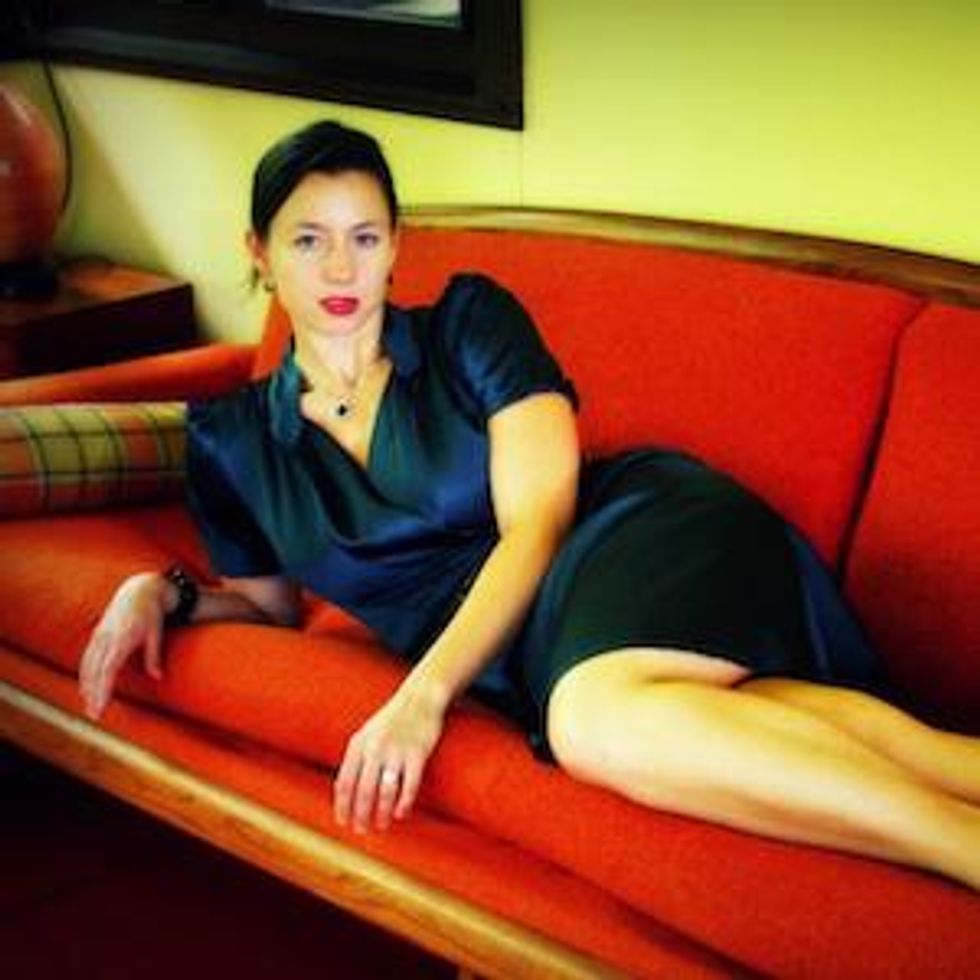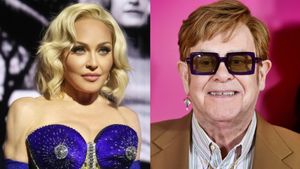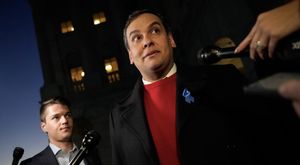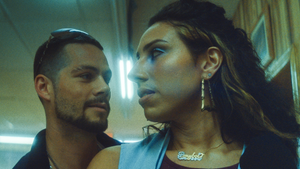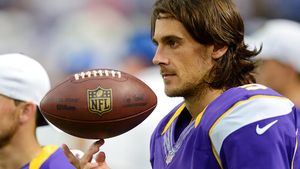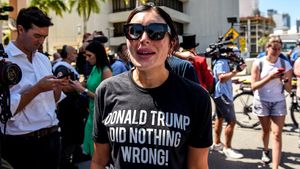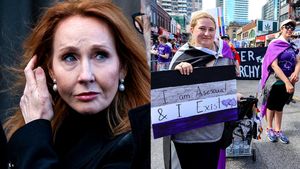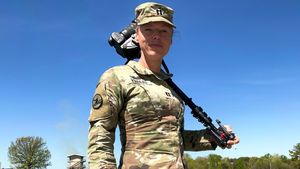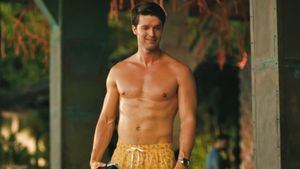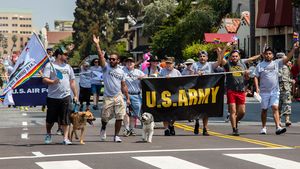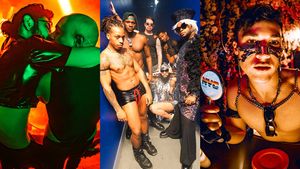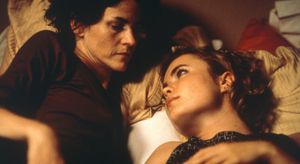An accomplished dancer, professor and first-time filmmaker Erika Randall Beahm was on the verge of delivering two ‘babies’ earlier this month, one, her first child with her husband, and the other, her feature film and pet project Leading Ladies, which was just coming out on DVD via the LGBT-friendly distributor Wolfe Video.
A professor of dance at The University of Colorado, Beahm, with her writing partner Jennifer Bechtel and her co-director, her husband Daniel, collaborated on Leading Ladies, a dance film rife with humor and romance in the classical Hollywood vein ala director Vincent Minnelli. That is, if Minnelli had dared direct a dance film that replaced the compulsory heterosexual couple with a lesbian couple who find love on the ballroom dance floor.
A favorite of both mainstream and LGBT film festivals Leading Ladies is a good old-fashioned romance, complete with an overbearing stage mother (Melanie LaPatin) and a sassy gay best friend, whose high kick puts the girls to shame(Benji Schwimmer). But the story turns on two love stories of sorts. The first, sisterly love between Tasi (Shannon Lee Smith) and Toni Campari (Laurel Vail), who couldn’t be more unalike – Tasi, the glamorous would-be star of the ballroom dance world, and Toni, the shy, unassuming pizza girl who reveals she’s got a few moves of her own.
While Tasi’s a star on the dance floor, it’s the smoldering Toni who’s at center stage of the film’s classical Hollywood romance as she meets and falls instantly in love with the vivacious Mona (Nicole Dionne) on a crowded dance floor, a scene that evokes the moment when Tony and Maria first meet in West Side Story.
A heartfelt lesbian love story that appeals to all who enjoy appreciate a compelling tango, Leading Ladies purposefully plays with a wink and a nudge to iconic dance films that came before it, turning the notion of gender and of “dancing backwards in heels” on it’s head. But then, Beahm, erudite in her film history, terpsichorean and bisexual, appears to be the perfect person to execute a dance film for the 21st century that embraces old-fashioned dance standards and modern politics.
Co-director and writer Beahm chatted with SheWired about conceiving of and executing the project with her co-writer Bechtel and her husband Daniel, the film festival circuit, the marriage of a traditional dance film with LGBT politics and the possibility that she might actually go into labor during the interview.
SheWired: I hear you’re about to go into labor, so first of all, congrats and secondly, that would be a first for me if it happens during our interview.
Erika Randall Beahm: Well I am officially in early labor, so I’ll pop your cherry on that one; it still could be days before we actually have a baby.
Well I’ll take it. You were hitting the film festival circuit pretty heavily for a while. How has that experience been for you?
It’s been amazing. I cannot believe we are first time filmmakers and we’ve played almost 60 festivals I think now. The film has had an appeal across both the LGBT lines and the quote-un-quote straight film festivals, which was our hope when my writing partner and I started writing the project.
We’ve gotten to travel all over the place. I think this fall the baby will take its first trip to Italy for a GLBT fest there. I think I’ll be in Florence -- that’s the plan. It’s been amazing.

What were some highlights of the film fest experience thus far?
We’ve had great screening at Palm Springs; we had two sold out screenings, at Palm Beach Film Festival we won best feature, at the Castro we had 900 people to play to at that beautiful historic theater. At our premiere at Sonoma International we won an award. That festival is just such a boutique love fest, and to get to play with Leading Ladies there and have most of our leads be there – it’s been a pretty extraordinary time. We’ve collected a lot of fans. And fans that we didn’t expect to become fans of a lesbian musical love story.
It sounds as though you really tapped into something with your audience.
It feels like it. In some of the straight festivals we’ve had a couple of older couples leave and we’ll talk about that in the Q&A’s.
More on next page...
\\\
(continued)
Because of the lesbian love story?
We had people say, “There were moments where I was uncomfortable,” and it’s funny because it’s a PG13 love story with a sweet make out scene. It’s just that it’s long and we indulge in it, and I think that makes people think, “How far is this going to go?” It’s our hope that they say, “But the dialogue brought me back, and I realize that gay couples have been watching straight couples kiss for decades on film, and so I felt welcomed back to the story.” I feel like we have won over a lot of people who wouldn’t’ typically see a quote-un-quote gay film. I think the dancing and the comedy does that.
Why the lesbian love story? The film could have easily been a dance film / romance about a straight couple.
I think there are three main reasons for that. My writing partner Jennifer Bechtel, the day that we met I walked into a store that she owned -- she heard me say that I was a dance professor-- and she said, “What do you know about gay and lesbian ballroom dance?” I mean, kind of out of the blue.
And I said, “Well, not a whole lot. But I know a lot about gay and lesbian swing dance because I use to do some of that.” I used to live in Seattle in the 90’s and I identify as bisexual and part of the gay and lesbian swing community, kind of vicariously at first, and then started to kind of get involved. There’s a great place called the Century Ballroom there in Seattle, and it was really inspirational.
Jen said she had been doing movie night for teens at her store and she wanted to do something for the GLBT community for teens, and there were no PG13 gay and lesbian films. She had been directing musical theater, and me as a dancer, I also love social dance and swing. We got this idea to kind of use that as a jumping off point to fill both the void in the gay and lesbian community for PG13 films and the gay and lesbian community in the dance films.
Since the film is a dance film, and you’re a dancer, and there’s also a love story between two women, and you’re bisexual, how much of the film, if any, is derived from your life?
We used kind of the skeleton of my life, of no one character with any one person. They’re all composites of different people Jen and I know or we made up. But I was raised by a single mom and the year my sister got pregnant I told my mom I had a girlfriend. We kind of used the plot line of my life from-- what was it?—93, as the architecture of the narrative.
I like to say that if sometimes we can’t walk in one’s shoes we can dance in them. That there’s a certain kind of movement that can happen on a political or social political wavelength if we’re feeling something. And if we can feel something through dance we can identify maybe better with a character’s experience because it’s not overtly political or dogmatic. It’s just two women dancing together, or two men dancing together, and then suddenly we’re kind of moved by that. And then they are literally moved into a different way of thinking. Dance felt like a great vehicle for that.

The film makes a political statement toward the end in that the lesbian couple enters the dance contest only to be turned away by homophobic judges. Why did you get political at that point when it could have just been a love story?
I think that since the audience is sort of primed at that point, they ‘re cheering, they’re rooting for the heroines… They want them to win as they would in a typical Hollywood musical. In Strictly Ballroom (Baz Luhrmann’s 1992 film) -- the under dogs, the ugly duckling -- they get to compete at least, and the crowd goes wild. And so there was that push, we want to see them compete, but in the end we really want to see them win. And winning in this case is acceptance by the family. There are little analogies, like the panel of judges of course, which you can take it seems is just a ballroom panel, but yeah, you can read that that’s the whole notion of judgment, and they talk a lot about the bylaws, which could be seen as the Bible. That’s how I have always thought of it.
Just that this mom goes full PFLAG on this judge’s panel is so empowering that ultimately, it’s about family. That’s the hope, especially when making a film for youth, for gay youth and for their families, that it’s ultimately about how we support our kids to be who they are, whether they’re dancing or getting bullied at school or just coming into their own. It felt like a nice way to twist that typical Hollywood story line -- put a little bit of kink in it, make a political statement without being overly dogmatic.
That you can read it that way or go, “Oh, I wanted to see them dance,” but the fact is, people who are saying that they wanted to see them dance --they are saying, “I wanted to see two women in partnership.”
More on next page...
\\\
(continued)
I’d like to talk about when Toni and Mona meet. Their chance meeting in the middle of a dance floor evokes so much of the iconic scene when Tony and Maria meet in the gym in West Side Story.
Thank you. You are exactly right.
So that was an intentional allusion?
Yes. Both Jen and I are huge musical theater fans. And that moment when everything just stops, I get goose bumps. And her name to begin with (Toni) and then we come back to Mona’s apartment, where she says, “Antoinette, I like it. It sounds longer. What does Toni stand for?” She references back to West Side Story. A lot of those great musical moments are in there, from Gypsy to West Side Story. There’s something that musical theater always kind of queers the human experience. Just the fact that men are skipping around instead of really beating each other and they’re in a gang. It’s just so wonderfully blithe.
We’ve been criticized for that scene being long. But to us it’s that slow sweet indulgent moment in time when you first fall in love. So that was a hope, especially in the editing, which I think that my husband did a beautiful job capturing
You got a wonderful review in Variety. Congratulations.
Amen! We were so nervous when we heard that a reviewer from Variety was at our New Fest screening. And you’re thinking, “Oh God, if they just say good dancing and you have one cool quote…” and the whole thing was just a delight.

The Variety piece mentioned that your film had none of the frenetic pace of a Baz Luhrmann film but you’ve already referenced Strictly Ballroom, and I must say, especially in some of the rehearsal scenes with Melanie LaPatin, who plays the mom, it’s just so over-the-top in a Strictly Ballroom sort of way. I couldn’t help but be reminded of that film while watching yours.
I mean, Moulin Rouge is one of the first films that my husband and I bonded around. The over-the-top indulgent style of it. And I had always loved Strictly Ballroom. And how do you make a ballroom dance film and an ugly duckling story and pay homage to but not copy? But there’s also something that where your clearing a story to copy it can also be kind of exciting, because you are using a known form and tweaking it. So all of the references are intentional in there.
Also, the Dirty Dancing references -- anybody who has watched that movie as many times as I did when I was 14 can’t miss those, and those are absolute nods to another brilliant heterosexual dance love story.
I want to get to more than just the homages but I think they are important, especially since you are appropriating them into a queer theme. There are moments in the film, like “The Toothbrush Tango” that hearken to old Hollywood Musicals in which the rhythm of everyday life becomes the dance. I’m thinking specifically of a film like Swing Time with Fred Astaire. Are you reaching back that far with your references?
Talking about this film is kind of all we’ve done for the past two years and it turns me on especially when talking with someone who notices those nuances. I’m a huge Fred Astaire fan but I think my heart is really with Gene Kelly and Leslie Caron. American in Paris -- I saw it on the big screen. I had to sneak out of an Uncle’s wedding to see that and then got perform in Australia and had a dressing room next to Leslie Caron, with her star on the door. My husband and I -- we love the past. That’s why we wanted the film to have kind of that timeless quality where you can’t, except for the cell phones, really nail down the time. That is in honor of the golden age of cinema.
I’d like to talk about the casting in the film. The chemistry between the sisters is just phenomenal but I’d love to know about casting the Toni and Mona, who fall in love. It’s really palpable.
We knew that casting Toni would be pivotal. We auditioned in New York and L.A. and Chicago in multiple trips to both New York and L.A., and finally on a second round in L.A., Laurel Vale, who plays Toni, and Nicole Dionne (Mona), they read together, and they did the almost break-up and my husband and I were both in tears. It was so obvious that that was Toni and Mona, and I had seen Mona as kind of buoyant but there was something that Nicole brought that sparked Laurel into magic even more and vice versa. The challenge however, and I say this at every Q&A, when we went to do the dancing part, Laurel had never danced a step, and she was terrible (laughs).

She was at a screening of the film at Film Out in San Diego and she mentioned that.
Bless her heart, she was terrible, but you could tell she’s smart. Benji Schwimmer (costar, additional choreographer) was at that audition and I pulled him aside and said, “You’ve been working with all of them out in the lobby and in the parking lot, can she be taught?” And he said, “She’s really smart.” We called Laurel and said, “If you train on your own dime for the next two months we want you for this.” She said, “Absolutely.”
More on next page...
\\\
(continued)
I read an interview with you in which you mention that Chasing Amy, which featured a bisexual lead character, was a very important film for you.
For me, the line, “When you chose someone out of 100 percent of the population…” when I heard that line, it was just so affirming to me. It brought so much kind of clarity about the path of my own personal heart. And that my heart has always had kind of a lighthouse version of love. A 360 -- it just falls in love. I don’t know that that’s true for everyone but there’s a Pollyanna part of me that would like to believe that we are all capable of that, but for me it’s true. And that film -- it’s a heart breaking film in a lot of ways, and it’s a ridiculous film in a lot of ways. But to get to see a strong woman at the time, who was just strong. She knew her heart and was like, “I’m choosing you, and then I might not choose you, and I might end up falling in love with someone else. It could be a man or a woman, but right now I’m choosing you out of 100 percent of the population,” has been a strong mantra for me.
And I think for someone who really believes in telling queer stories or femme-centric stories, one of the challenges I face is, in different communities people want different endings. Where in the lesbian community if the girl doesn’t get the girl and she ends up with the guy then you’ve failed. As a bisexual person that doesn’t necessarily mean failure. I ended up with a partner who happens to be a man but we’ve been together for 12 years. And it’s a good relationship. But it’s good because of our honesty and communication and my ability to be fully who I am.
I think things are becoming more fluid now but it used to really feel like bisexual people had to choose a community.
I have felt less embraced because I am not in the overtly queer eye. Because I have long brown hair and now I’m having a kid, which, is extra points against me.
Well a lot of lesbians are doing that.
I know. Thank God now that’s cool. You don’t get the breeder status as much. So I think Chasing Amy, for me, that she didn’t end up with the man at the point in my life was really important. The guy doesn’t get the girl; the girl gets the girl in the end. But she still has a place in her heart for him. And this is a kind of a conundrum I think where you can get thrown into these binaries, especially bisexuality can be so focused on, “Oh that was the experimental years and oh, you gave up your toaster, and now you’re straight.” But can you still be both / and? Whether you’re in a monogamous relationship, whether you’re with a man or a woman. I just think these are big and important questions, like why the lesbian community was so excited when Anna Paquin came out even though she didn’t need to. She has a fiancé. But it was important that she still said I am capable of love 360 degrees. Chasing Amy was a fist moment for me where I thought, “Okay, I can be okay no matter who I’m with and I can’t always judge myself by the community’s standards.” When you’re in your early twenties / late teens those monikers give you energy -- being a lesbian can really give you strength and power. And then it’s like, “Ok, what about just being strong and loving who I love and not taking my identity from the community?” Those are tough, tough challenges.

Erika Randall Beahm and Daniel Beahm
I know that your biggest upcoming project will be becoming a mom but is there anything else in the works you’d like to discuss?
We’re really thrilled about the release with Wolfe because so many of Wolfe’s fans actually buy video where most people any more wait for NetFlix or get it for free. They don’t understand how to support independent filmmaking. The festivals do but beyond that it’s tricky, you don’t get the million dollar deals that they were giving to El Mariachi (Robert Rodriguez’s 1992 indie). It doesn’t happen like that.
We made this film for very little money, and my husband did almost everything in post-production. That was how we were able to stay on budget, but that means two years, so no paycheck. So we want people to buy the video, and I think what’s great about the gay community is that they support gay film and gay filmmakers and actually buy them instead of steal them, well not steal them, but you know, download stuff and Netflix . People don’t realize how much you don’t make on that stuff as an independent filmmaker on Netflix. So we are exciting that the video is already shipping, and it’s crazy too. It’s shipping at the same time that this baby is about to ship out, so both our babies are coming into the world at the same time.
I have one last question. Do you have baby names picked out?
We don’t know boy or girl. If we have a boy Ezra is the boy name. It means the scribe. Being from the Midwest, both of us, and kind of having a heart for adventure, if we have girl we will name her Indiana. She’ll be our little Indy film girl. Or Indiana Jones girl, or Indiana is where my husband is from. Indiana, and then the middle name would be Isadora for Isadora Duncan, the rebel bisexual mother out of wedlock. We just won’t let her wear any scarves. But if we have a boy we will probably name him Ezra Indiana I think Indiana will get in there any way.
Follow SheWired on Twitter!
Follow SheWired on Facebook!
